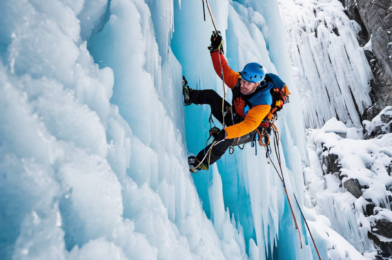crampon technique is critical for stability and balance. Learn how to position your feet correctly, using the front points for precise placements and the flat areas for stable platforms. Practice different crampon techniques, such as front-pointing, flat-footing, and French technique, to adapt to varying terrain.
Belaying is another critical skill for ice climbing. This requires understanding the mechanics of a belay system, including the use of an ice screw and a rope to safely catch a falling climber. Practice until you feel confident in your ability to manage the rope and communicate effectively with your climbing partner.
Navigating varying ice conditions is an important skill to develop. Ice climbing presents unique challenges, from brittle ice to soft and muddy conditions. Learning to identify and adapt to these variations will ensure a safer climb. Understand the different types of ice and the techniques required for each, such as dry tooling for rock sections or mixed climbing techniques for ice-covered rocks.
Risk management and safety awareness are also vital. Assess potential hazards, understand fall consequences, and plan your climb accordingly. Learn about avalanche terrain and its potential dangers, and always carry and know how to use the necessary safety equipment, such as an ice axe and a helmet.
Climbing with a partner is an essential skill for safety and enjoyment. Effective communication, belaying techniques, and rope management are all part of this. Learn how to move in tandem with your partner, manage the rope efficiently, and provide encouragement and support when needed.
Self-arresting is a critical skill to stop a fall and prevent sliding down the ice. Practice self-arrest techniques with your ice axe to gain confidence in stopping a potential fall. Additionally, climbing efficiently requires good fitness and endurance. Focus on building your strength, endurance, and flexibility to handle the demands of ice climbing.
Understanding how to ascend and descend fixed ropes is another critical skill. This involves using Prusik knots and mechanical ascenders to climb up or down a rope fixed to the ice. Practicing good rope management is also key to a safe climb. Learn how to coil and manage the rope effectively, avoiding tangles and ensuring smooth transitions during your climb.
Lastly, navigating and route-finding are important skills to develop. Learn to identify and follow routes, assess hazards, and make informed decisions about your climb. Understanding topo maps, recognizing landmarks, and using a compass and GPS will ensure you can navigate confidently on the ice.
Ice climbing is an incredibly rewarding and unique sport that requires dedication to mastering these essential skills. Always remember to prioritize safety, practice environmentally mindful climbing, and seek professional instruction to develop your ice climbing skills confidently and effectively.








